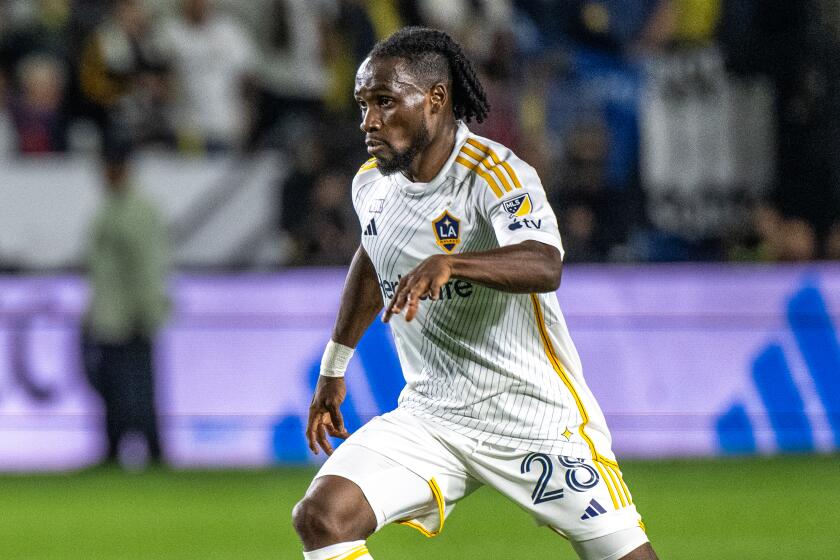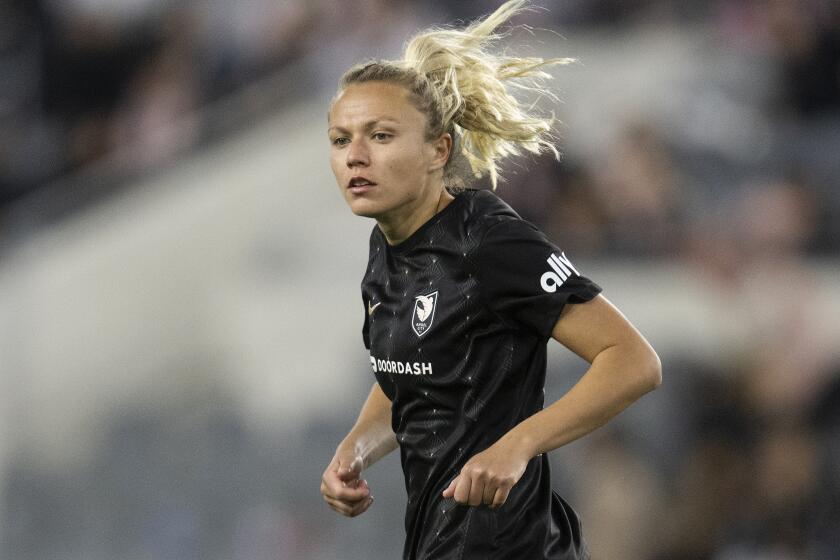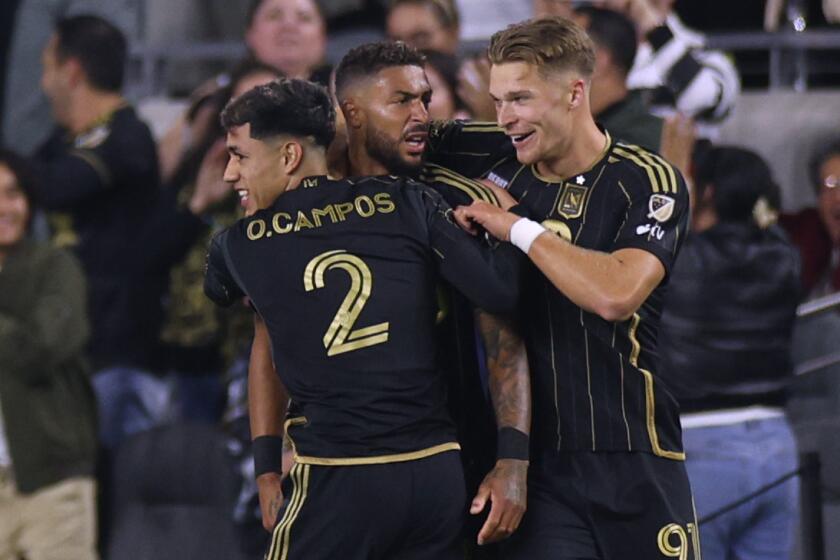Newsletter: Soccer! New MLS playoff format has its flaws

Hello and welcome to this week’s edition of the L.A. Times soccer newsletter. I’m Kevin Baxter, The Times’ soccer writer, and we have a lot of odds and ends to go over in the final newsletter of 2018.
We’ll start with Major League Soccer, which announced Monday that it has adopted a new playoff format for 2019, one that both expands the number of teams but reduces the number of postseason games.
The top seven teams — one up from 2018 — in both the Western and Eastern Conferences will advance to the playoffs, which will begin Oct. 16, with the top team in each conference getting a first-round bye. That means 14 of the league’s 24 teams will make the playoffs next season.
All playoff rounds will consist of single-elimination games rather than the two-leg, home-and-home series MLS has previously used for the conference semifinals and finals. The MLS Cup final will be played Nov. 10.
The condensed schedule will allow the league to play all its postseason games between the final two FIFA international breaks of the season, a welcome change that means the playoff momentum will no longer be interrupted by international games. But I don’t like the elimination of the home-and-home conference semifinals and finals because that will rob at least four teams of a chance to play a postseason game in front of their home supporters.
Instead the new format sets up a scenario in which a high-seeded team could go on a daring postseason run to an MLS title without ever playing at home.
Plus soccer, as a low-scoring sport, is ripe for freakish upsets. Giving teams that have excelled through a seven-month regular season a second leg to overcome that seems fair.
Using a seven-month season to eliminate fewer than the half the teams also seems bizarre. I understand MLS is growing the field with an eye toward further expansion, to 28 teams, in the near future. But even then, 14 of the 28 will make the playoffs, and that’s still too many.
More than half the teams make the NBA and NHL playoffs compared to one-third in Major League Baseball and 12 of 32 in the NFL. Regular-season excellence should mean something, and mediocrity should not be rewarded with a postseason berth.
It would be preferable to trim the playoff field to five teams in each conference with a single-elimination wild-card round, two-leg series in the conference semifinals and final and then the MLS Cup. Under that format the tournament could still be held entirely between the international breaks, and teams with losing regular-season records likely wouldn’t qualify.
The 2019 MLS regular season, consisting of 34 matches, will begin March 2 and end Oct. 6, a month earlier than in previous years. The league will play additional midweek games to accommodate the new schedule.
Speaking of the MLS playoffs
Only one of Southern California’s two teams made the playoffs last year, so the Galaxy — who finished seventh in the table, which would get them into the dance in 2019 — have understandably had the more pressing offseason business to attend to.
In the last week the team formally welcomed a new general manager in Dennis te Kloese and announced the re-signing of striker Zlatan Ibrahimovic to a designated-player contract. How they’ll open a DP spot for that contract is still to be worked out, as is the hiring of a new manager after Caleb Porter, the team’s top candidate, unexpectedly turned down the team’s offer late last week. And that’s left Te Kloese and the rest of the front office scrambling to find a replacement less than five weeks before the start of training camp.
It was always going to be a busy offseason for the Galaxy, who missed the postseason for a second consecutive year. It’s both a sign of how great the franchise has been and how deep a hole it is currently in to know that the Galaxy has now gone four years without appearing in the MLS Cup final, the team’s longest drought ever.
The Los Angeles Football Club, which did reach the postseason in its first year, busied itself by trading defender Joao Moutinho, signing midfielder Mark-Anthony Kaye to a contract extension and is still trying to re-sign defenders Walker Zimmerman and Danilo Silva and midfielder Benny Feilhaber.
But LAFC is also rearranging the furniture a bit at Banc of California Stadium, adding a North End Terrace with room for 180 fans and midfield boxes with a capacity of 300. The addition of the new premium seating areas, which will be sold on a season-ticket basis, required the removal of some seats that had been reserved for single-game and group purchases. The stadium’s 22,000-seat capacity will not change but LAFC’s season-ticket sales will increase to about 18,000 for 2019.
“When we designed the building we had a notion, an idea that we’d have the flexibility to add more club seats in certain locations,” LAFC president Tom Penn said Monday. The addition of higher-priced premium seating sections for a club that bills itself as gritty and blue-collar seems out of character, but Penn said feedback the team got from its fans indicated there was a demand for new options.
Penn called the North End Terrace, which will look down on the supporter section that is home to the rambunctious 3252 fan group, “the most unique club in all of professional sports. You feel that energy, you’re in the middle of all that energy [but] you’ve got your own private lounge area.”
LAFC made another offseason move when it ended its affiliate agreement with the Orange County Soccer Club after two seasons. The partnership served both clubs in 2017, when LAFC did not have a first team and needed a place for players to play. But it wasn’t nearly as useful last year, with LAFC loaning twice as many players to Orange County’s USL rivals in Las Vegas and Phoenix as it did to its official affiliate.
“We are our own organization with our own goals,” said Oliver Wyss, Orange County’s general manager and executive vice-president. “That was a normal evolution. LAFC has their own goals and their own direction. And we have our[s].”
Instead OCSC announced Tuesday that it will partner with the L.A. Wolves and Anaheim Legacy of the United Premier Soccer League, agreements that fit in much better with the team’s “pathway to professional” approach of developing talent on its way up to MLS rather than babysitting prospects or injured players who have already signed with the league.
“The affiliation with the L.A. Wolves and the Anaheim Legacy and probably other UPSL teams down the line are simply to strengthen that pathway to professional. Because they have a lot of talented young players that should be given the opportunity to see if they can play at the next level,” Wyss said. “When they have an exceptional player that we all know has the potential to play a higher professional level, they’ll send them to us, recommend them to us, [and] we will potentially bring them in to our training and our environment and evaluate them.
”We don’t ever want to be the end piece. We want them to go on to the highest level possible. That might the MLS. Or that might be in Europe or Mexico or somewhere else.”
Wyss said his team is open to affiliate agreements with other teams as well.
“We are obviously in active talks and have active interest from other MLS teams and from other international teams that have recognized that we are at the forefront of developing players and giving young players the ability to play and showcase themselves.”
Who’s the home team again?
It’s long been assumed that the most popular national team in the U.S. is the Mexican one. And WorldSoccerTalk.com offered some proof last weekend with a report that attendance at the six games El Tri played in the U.S. in 2018 was 146% higher than games featuring only the U.S. national team.
Friendlies involving Mexico drew an average attendance of 59,678 this year as compared to the 24,163 the U.S. averaged for seven games. That’s a huge jump from 2017 when the U.S., which played a series of World Cup qualifiers at home, averaged 29,400 to Mexico’s 43,586.
There are reasons for the difference, of course. The Mexican team was preparing for the World Cup in 2018 while the U.S. had nowhere to go and was largely auditioning young players for the next World Cup cycle.
2018 Mexico Attendance in the US:
1/31/18 – Friendly – Mexico vs. Bosnia & Herzegovina – Alamodome – 26,867
3/23/18 – Friendly – Mexico vs. Iceland – Levi’s Stadium – 68,917
3/27/18 – Friendly – Mexico vs. Croatia – AT&T Stadium – 79,128
5/28/18 – Friendly – Mexico vs. Wales – Rose Bowl – 82,345
9/7/18 – Friendly – Mexico vs. Uruguay – NRG Stadium – 60,617
9/11/18 – Friendly – Mexico vs. USA – Nissan Stadium – 40,194
• Total Attendance: 358,068
• Average Attendance: 59,678
Source: WorldSoccerTalk.com
Three of the U.S. games drew fewer than 12,000 fans while its biggest crowd was the 40,194 that showed up in Nashville to watch the game against, you guessed it, Mexico. Take away that game — a U.S. home match — and Mexico averaged 63,575 for five games.
Speaking of Mexico
Soccer America has compiled a global list of the 10 largest crowds to watch a women’s soccer match this year and five of them were in Mexico, including the 51,211 that saw Tigres beat Monterrery on penalty kicks in the Clausura final last May. All five Mexican games involved Tigres. The list:
51,211: Mexico – Monterrey vs. Tigres, Liga MX Femenil, Clausura
45,423: England – Chelsea vs. Arsenal (FA Women’s Cup)
41,121: Mexico – Tigres vs. Club America, Liga MX Femenil, Apertura
38,230: Mexico – Tigres vs. Monterrery (Liga MX Femenil, Clausura)
37,601: Mexico – Tigres vs. Monterrey (Liga MX Femenil, Apertura)
33,420: Mexico – Club America vs. Tigres (Liga MX, Femenil, Apertura)
30,238: Netherlands: Netherlands vs. Northern Ireland (World Cup qualifying)
25,706: U.S. – U.S. vs. France (friendly)
25,603: England – England vs. Wales (World Cup qualifying)
23,750: Netherlands – Netherlands vs. Switzerland (World Cup qualifying)
Podcast
Don’t miss my weekly podcast on the Corner of the Galaxy site as cohost Josh Guesman and I discuss the Galaxy each Monday. You can listen to the most recent podcast here.
Happy New Year!
Barring any major news, this will be the final newsletter of 2018 since I’ll be traveling back from the final Rams road game of the NFL regular season next Monday. So don’t expect a newsletter on Dec. 25. We do, however, hope to return on New Year’s Day. In the meantime have a happy holiday season, however you choose to celebrate it. And if you have any suggestions or criticisms of this newsletter or ideas how we can make it better for 2019, please don’t hesitate to share. Subscribe here, and I’ll come right to your inbox. Something else you’d like to see? Email me. Or follow me on Twitter: @kbaxter11.







